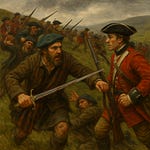Today, we turn our attention to a mysterious and controversial event that took place on August 5, 1600, known as the Gowrie Conspiracy. This event allegedly involved an attempt on the life of King James VI by the Gowrie family in Perth. To unravel this historical enigma, we delve into the life of John Ruthven, the 3rd Earl of Gowrie, and the events leading up to that fateful day.
John Ruthven, born around 1577, was the second son of William Ruthven, the 1st Earl of Gowrie, and Dorothea Stewart. He inherited the title of Earl of Gowrie as a child after the death of his brother James in 1586. The Ruthven family had a complex history marked by political intrigue and rebellion. John’s father and grandfather were known for their involvement in conspiracies against the crown, aligning themselves with reforming preachers and the Kirk party.
Educated at the grammar school of Perth and the University of Edinburgh, John Ruthven's early life was steeped in the turbulent political climate of Scotland. His family’s connections with the Protestant reformation movement and their opposition to the Scottish crown set the stage for his later actions. In 1592, John was elected Provost of Perth, a position that had almost become hereditary in the Ruthven family. His political affiliations and education led him to travel extensively, including a notable period in Italy at the University of Padua and later in Geneva with the reformer Theodore Beza.
By February 1600, Ruthven had returned to Scotland and found himself embroiled in courtly disputes. An encounter at Holyrood Palace with William Stewart of Houston, who had arrested his father years earlier, hinted at the simmering tensions between Ruthven and the court. Stewart's complaints about Ruthven’s perceived slight indicated the precarious position Ruthven occupied at court.
The Gowrie Conspiracy unfolded on August 5, 1600, with King James VI rising early to hunt near Falkland Palace. During the hunt, he was approached by Alexander Ruthven, John’s younger brother, who claimed they had detained a foreigner with a large sum of money at Gowrie House in Perth. Alexander urged the king to interrogate the man personally, leading James to agree to visit Gowrie House after the hunt.
Arriving in Perth with a small retinue, King James found no preparations had been made for his visit. After a brief meal, James was led by Alexander through a series of locked rooms into a secluded turret. Here, instead of finding the alleged prisoner, James was confronted by Alexander, who threatened him with a dagger. A struggle ensued, and James's cries for help alerted his followers. John Ramsay, one of the king’s men, managed to break into the turret and fatally wound Alexander. John Ruthven, rushing to his brother’s aid, was also killed in the ensuing melee.
The immediate aftermath saw the deaths of both Ruthven brothers and the survival of King James. The motives behind the conspiracy remain shrouded in mystery. Some historians suggest the Ruthvens intended to kidnap the king, possibly to coerce political changes or exact revenge for their father’s execution. Others propose more sinister motives, including theories of amorous advances rebuffed or a plot orchestrated by James to eliminate his creditors and enemies.
The repercussions of the Gowrie Conspiracy were severe for the Ruthven family. Their estates were forfeited, the family name was abolished, and their bodies were disemboweled and publicly displayed. The mystery surrounding the event has never been fully resolved, with theories ranging from political intrigue to personal vendettas.
As we reflect on the events of August 5, 1600, we are reminded of the turbulent and often dangerous nature of Scottish politics during this period. The Gowrie Conspiracy remains one of the most enigmatic episodes in the history of King James VI’s reign.













Share this post